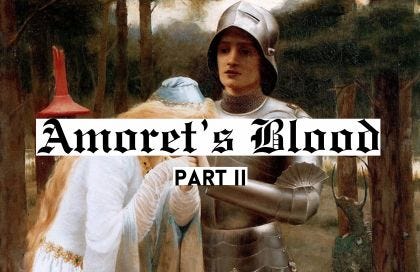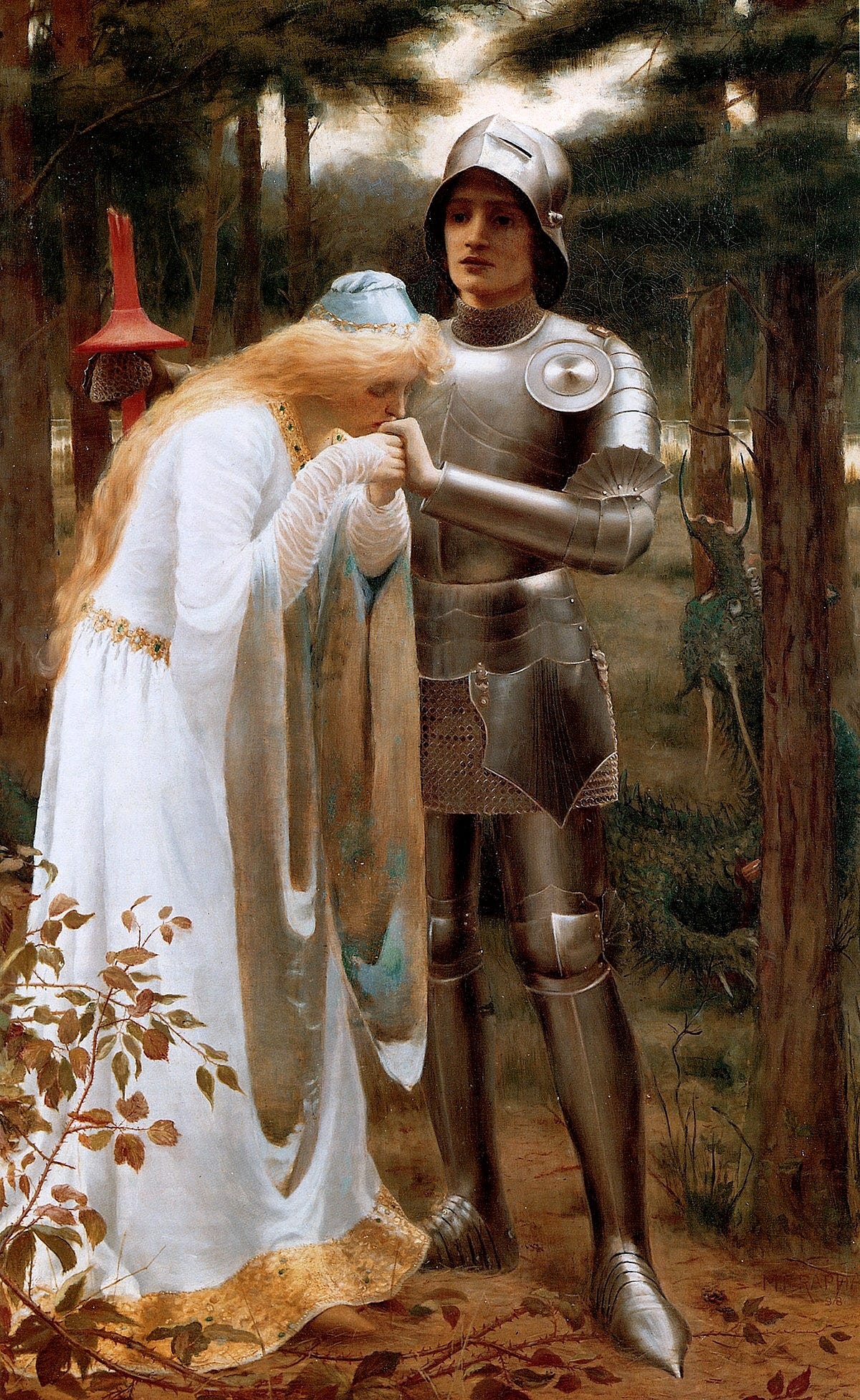Hello, fellow ghost reader!
Welcome back to my Substack!
Today I’m publishing Part 2 of 4 of ‘Amoret’s Blood’ — an essay I wrote for my Master’s degree for a module I took on Edmund Spenser’s The Faerie Queene.
It’s an exploration into the presence and significance of blood in Book III Canto xii of TFQ, where the female knight, Britomart, ventures into the house of Busirane - a wicked magician who has kidnapped Amoret and is attempting to torture her into loving him - in order to rescue Amoret and return her to her witless true love Scudamore.
Last time we looked at the scene from Amoret’s own perspective. This time, we’re examining the presence of her lover Scudamore who, incapable of rescuing her himself from the passions of the wizard Busirane, employs the fearsome warrior Britomart (whom he believes to be a man) to save his love from her captors.
(You can find Part I here, or for more Faerie Queene content you can read my mini essay on space and language in the opening stanzas here.)
Enjoy!
A ghost reader 👻
tw: this essay includes references to sexual violence and torture
Amoret’s Blood
II.
Having examined the immediate experience of Amoret’s suffering, we must view this scene from its farthest perspective. Scudamore does not participate in the torture of Amoret, witness her tourment, or even make it through the front door. In our minds, Scudamore is identified by his, frankly pathetic, inability to defend his love, and who has even given up trying, having ‘rudely’ (having the meaning ‘disgust’) cast off his shield. The disgusted rejection of the shield, Walkden asserts, is important as it illustrates (literally) his connection to the god, Cupid:
the winged boy in colours cleare
Depeincted was, full easie to be knowne,
And he thereby, where euer it in field was shown.
(III.xi.7.6-9)
Not only does Spenser choose to depict Cupid on the shield (arguably the most significant identifier of Spencerian armour), but his repeated emphasises on the clarity of his depiction forces us to visualise it as an aesthetic object, and cementing Scudamore in our minds as ‘Cupid’s man’. Even the name Scudamore (scud, ‘shield’; amor, ‘love’) directs our perception of his allegorical identity, and it is with this in mind, that Walkden posits the question: ‘Shouldn’t Cupid’s man be able to rescue Venus’s maid?’1 This naturally suggests a crisis in masculinity for Scudamore, but this essay is more concerned with Spenser’s insistence on the proximity between Scudamore and Cupid, which suggest to us that Scudamore is not merely Cupid’s acolyte, but that there is an extent to which Scudamore is presented as Cupid.
Although Cupid is an actual character, he is often only present as a kind of phantom. His first appearance in Book III comes when his mother, Venus, goes wandering the earth in search of him after he has ‘fled away’ to ‘[wander] in the world [...] Disguiz'd in thousand shapes’ (III.vi.11.6, 8-9). It is, of course, no accident that this description of the ‘winged god of love’ (II.vi.11.2) notes his ability to change shape. Cupid’s agency extends beyond his body to some degree, ruling Scudamore even from afar, and creates a sense of duality between Cupid and Amoret in their destabilised identities. William Junker draws our attention towards Amoret’s upbringing as a replacement for Cupid, asserting that Amoret’s name is given to her by Venus after her missing son (III.vi.28.8-9).2 In this way, Amoret is reaffirmed as a figure whose identity is insufficient to sustain itself as an individual - not dissimilar to Cupid(/Scudamore)’s mutable identity. But, before we are able to fully grasp the implications of this as a facet of Scudamore’s gaze upon Amoret, we must first consider the simple acknowledgement of a familial connection between Cupid and Amoret. Even though there is no evidence of the two ever coming into contact, there is also no denying that the idea of Venus raising both children in the same way, to the same ends, performs a sibling experience. This is notable for its implications on the way Scudamore imagines Amoret’s blood - not as a space which is lacking (as she perceives it), but one upon which identity and love can be imposed to aesthetic idealisations, even if they lack internal substance. Furthermore, it is especially interesting that Spenser chooses to reconstitute her blood alongside Cupid’s. The consequences of this realisation are extensive in a text which is constantly attempting to regenerate bodies, let alone where one of those figures regenerates in the body of the others’ lover. Even if she is not his sister by blood, Amoret’s performed familial relationship with Cupid constructs a bloodline in its abject space, which is then assumed by her ineffectual, but devoted, betrothed, contextualising the desire for Scudamore, which she so valiantly keeps from Busirane, in terms of a quasi-incestuous dynamic. Moreover, this figures Amoret’s identity as one that, like her brother’s, reaches beyond the boundaries of her body. This is perhaps the reason her heart is able to be removed in Cupid’s presence (III.xii.20-2), where it remains ‘stedfast’ against Busirane’s attempts (III.xii.31). In this way, we might think of her blood as the yonic version of Cupid’s phallic dart - just as the dart pierces the body and inseminates it with desire, Amoret’s blood subsumes the identity of those who desire her in ways which are as uncanny and uncomfortable as Cupid’s dart is painful.3
Such a depiction of transgressive desire lends credence to Walkden’s interpretation of forceful ‘disgust’ as Scudamore attempts to discard his shield4 as a silent, perhaps unconscious, acknowledgement of guilt, and affirms Amoret’s torture in terms of its violent illustration of the grotesque and pornographic body. However, its importance in the house extends beyond just a depiction of debased desire, turning our attention to the debasement of a body which is allowed to move beyond its narrow confines. Kent R. Lehnhof aligns Faerie Queene incest as a villainous quality which he argues Spenser deploys to disassociate Queen Elizabeth I from the traitorous incest allegedly committed by her mother, Anne Boleyn, in order to extol Elizabeth’s comparative virtue.5 Conceptualising an absolute understanding of Amoret’s potential incest in terms of this virtue-vs.-sin dynamic might be possible, however, to view Amoret’s transgressive desire as nothing more than that would fail to make sense within a narrative which views her as worth saving. Instead, we are only able to understand this interpretation in terms of its relationship to her blood and its abject nature as it is perceived by Scudamore, who, in contrast to Amoret’s experience, sees her body as possessing ‘too much’ blood - too familiar an identity - and must make her bleed before he can have her. From this perspective, the house is transformed into Scudamore’s BDSM fantasy, one in which he (Cupid) rides in on the back of a lion - a portrait of masculine ideals - to purge Amoret of her offending blood in readiness for his claim. In the 1590 edition’s conclusion to Book III Amoret is rescued and reunited with Scudamore, however, though the sight of her initially brings Scudamore joy (III.xii.44.1), her presence outside of Scudamore’s fantasy space soon disintegrates upon physical contact:
he clipt her twixt his armes
[...]
But she faire Lady ouercommen quight
Of huge affection, did in pleasure melt
(III.xii.45.1, 5-6)
The use of ‘But’ indicates that Amoret’s body ‘melt[ing]’ with his possesses negative connotations for Scudamore. Their depiction here as ‘that faire Hermaphrodite’ (III.xii.46.2), having effectively become one body, does not, as Maurice Hunt suggests, ‘[solve] the problem of love’s pain, simply because the two no longer feel [absence, deprivation and yearning]’.6 Instead, it is the horrific manifestation of their transgressive desire for familial blood realised in the merging of their shared body, as Scudamore is forced to comprehend that his purge of Amoret’s abject blood was nothing more than a sexual fantasy - ‘Her bleeding brest [now] closed vp, as it had not been bor’d’ (III.xii.38.4-5).
To be continued 17th January…
Andrea Walkden, ‘Allegorical Insubordination and the 1596 Faerie Queene’ Studies in English Literature, 1500-1900, 48.1 (2008), 93-109 (p. 95-96) <https://www.jstor.org/stable/40071323> [accessed on 30 November 2023].
William Junker ‘Spenser’s Unarmed Cupid and the Experience of the 1590 Faerie Queene’, ELH, 79.1 (2012), 59-83 (pp. ) <https://www.jstor.org/stable/41337579> [accessed 2 December 2023].
Maurice Hunt, ‘Transforming Love’s Pain in The Faerie Queene’ Explorations in Renaissance Culture, 32.1 (2006), 3-32 (pp. 26) <
https://doi.org/10.1163/23526963-90000308> [accessed 5 December 2023].
Walkden ‘‘Allegorical Insubordination and the 1596 Faerie Queene’ (p. 96).
Kent R. Lehnhof ‘Incest and Empire in The Faerie Queene’, ELH, 73.1 (2006), 215-243 (pp. 216-217) <https://www.jstor.org/stable/30030008> [accessed 1 December 2023].
Hunt, ‘Transforming Love’s Pain in The Faerie Queene’, p. 13.




